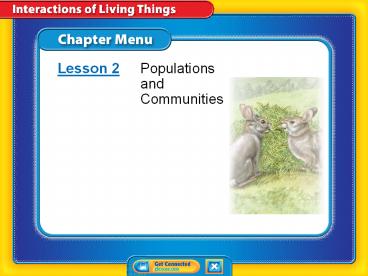Chapter Menu PowerPoint PPT Presentation
1 / 14
Title: Chapter Menu
1
Chapter Menu
Lesson 2 Populations and Communities
2
Lesson 2 Reading Guide - Vocab
Populations and Communities
- limiting factor
- biotic potential
- carrying capacity
- habitat
- niche
- symbiotic relationship
3
Lesson 2-1
Populations
- The area in which a population lives can be very
large, such as the population of all the fish in
the ocean, or very small, like fish in a lake. - If either biotic or abiotic factors that affect
an organism change, that organisms population
can also change.
4
Lesson 2-1
- The area a population lives in can be large or
small.
5
Lesson 2-1
Populations (cont.)
- Sometimes the size of a population changes
because the ecosystem changes. - Population density describes the number of
organisms in the population relative to the
amount of space available. - If a population is very dense, organisms might
have a hard time finding enough resources to
survive.
6
Lesson 2-1
- The size of a population can change in different
ways.
7
Lesson 2-1
- Limiting factors are factors that can limit the
growth of a population.
8
Lesson 2-1
Populations (cont.)
- Biotic potential is the potential growth of a
population if it could grow in perfect conditions
with no limiting factors. - Carrying capacity is the largest number of
individuals that can survive in an area over a
long time. - The limiting factors of an area determine the
areas carrying capacity.
9
Lesson 2-1
Populations (cont.)
- Overpopulation is when a populations size grows
beyond the ability of the area to support it. - This often results in overcrowding, a lack of
resources, and an unhealthy environment.
10
Lesson 2-2
Communities
- All the populations in the same area interact as
a community.
11
Lesson 2-3
Symbiotic Relationships
- Each population has different ways to stay alive
and reproduce. - All of the populations in a community share a
habitat, the physical place where a population or
organism lives. - A niche is the unique ways an organism survives,
obtains food and shelter, and avoids danger in
its habitat.
12
Lesson 2-3
Symbiotic Relationships (cont.)
- A symbiotic relationship is one in which two
different species live together and interact
closely over a long period of time. - These relationships can be beneficial to both
organisms, beneficial to one and harmful to the
other, or beneficial to one and neutral to the
other.
13
Lesson 2-3
Types of Symbiotic Relationships
- Mutualismtwo species in a community benefit from
the relationship. - Parasitismone species (the parasite) benefits
while another (the host) is harmed. - Commensalismone species benefits and the other
is neither helped nor harmed.
14
Lesson 2 - VS
- The factors that limit the size a population of
organisms can reach are called limiting
factors. - A habitat is the physical environment where a
population of organisms lives. - A symbiotic relationship exists when two
different species of organisms live together in a
close relationship over a long period of time.

